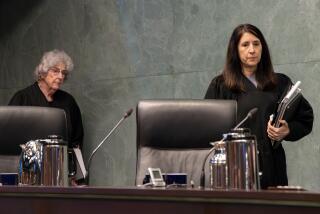High court rules for older workers
WASHINGTON — The Supreme Court gave the nation’s older workers stronger protections against age bias Thursday, ruling that employers who are sued must prove their layoff policies are reasonable and do not have an unfair effect on employees because of their age.
The 7-1 decision puts private companies and public agencies on notice that they must defend the criteria they use for layoffs if the cutbacks disproportionately affect older workers.
For example, when employers reduce the workforce, they sometimes rate their workers in deciding who is to be let go. Usually, the ratings focus on specific skills and can include subjective criteria such as “flexibility” or “creativity.”
In the past, the Supreme Court has said older workers can sue for age discrimination when layoffs hit older workers hardest. But it had been unclear whether the workers who were suing had to prove that the criteria used by the company were unfair or whether the company had to prove they were reasonable.
The justices decided on the latter.
“The burden is properly placed on the employer,” Justice David H. Souter said. “There is no denying [this] makes it harder and costlier to defend” against such lawsuits, he added.
Advocates for older workers, including AARP, hailed the decision. They said it would strengthen the rights of laid-off workers to challenge supposedly “neutral” corporate policies that fall heavily on older employees.
Several business groups predicted that it would lead to more lawsuits, and management lawyers called the ruling a significant change in the law.
The burden “is now squarely on the shoulders of employers,” said Sheryl J. Willert, a lawyer in Seattle. She cautioned employers who rely on subjective factors for deciding on layoffs: “It is more imperative than ever that employers engage in very clear evaluation and analysis and remove as much subjectivity as possible from business decisions.”
When Congress outlawed age discrimination in 1967, choosing age 40 as the triggering point, it said employers may use job qualifications that differentiate among workers “based on reasonable factors other than age.”
Unlike race or gender, age is a relevant factor in certain jobs. No one has contended that baseball players are victims of illegal age discrimination because few of them are over 40.
Although employers can rely on job criteria that may have an adverse effect on older employees, the court’s ruling makes clear that they will have to show they are justified. The court’s opinion did not spell out what is meant by a “reasonable factor other than age.”
Lawyers said, however, that shifting the burden of proof is likely to tip the balance in favor of employees in some cases.
In Thursday’s decision, the high court revived a lawsuit by Clifford Meacham and 27 older employers at government-funded Knolls Atomic Power Laboratory in New York state who were laid off more than a decade ago. When the lab lost a contract, it was forced to reduce its workforce. Employees were rated on criteria such as “flexibility” and “critical skills.” In the end, 31 employees were laid off; 30 were over age 40.
A jury ruled for employees in the Knolls case and said the layoff policy had an unfair effect on older workers. The plaintiffs were awarded $6 million in damages.
Last year, the U.S. court of appeals in New York reversed the jury’s verdict and said the employees had not proved that the layoff standards used by Knolls were unreasonable. The Supreme Court, in turn, reversed that decision in Meacham vs. Knolls.
Only Justice Clarence Thomas dissented. He maintained that the court was wrong to say the anti-age-bias law extends to cases challenging layoffs as having an unfair effect on older workers.
Justice Stephen G. Breyer took no part in the decision because he owned stock in one of the affected companies.
Although the case before the court focused on layoffs, the ruling applies to other job actions, including demotions, promotions and salary adjustments.
The decision does not forbid employers to use performance standards that might work against older employees. For example, the National School Boards Assn. said schools needed teachers who were comfortable with new technologies and could speak a second language. And younger teachers are more likely to have these skills, the group said.
Thursday’s opinion makes clear that employers can rely on such criteria but that they also have to defend them as reasonably related to the work and not a pretext for age bias.
--
More to Read
Inside the business of entertainment
The Wide Shot brings you news, analysis and insights on everything from streaming wars to production — and what it all means for the future.
You may occasionally receive promotional content from the Los Angeles Times.











